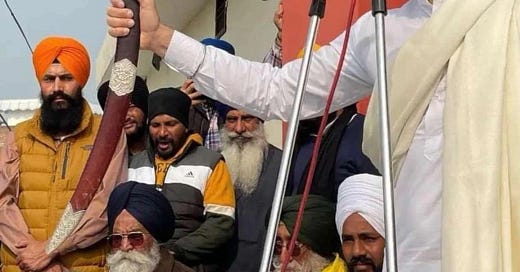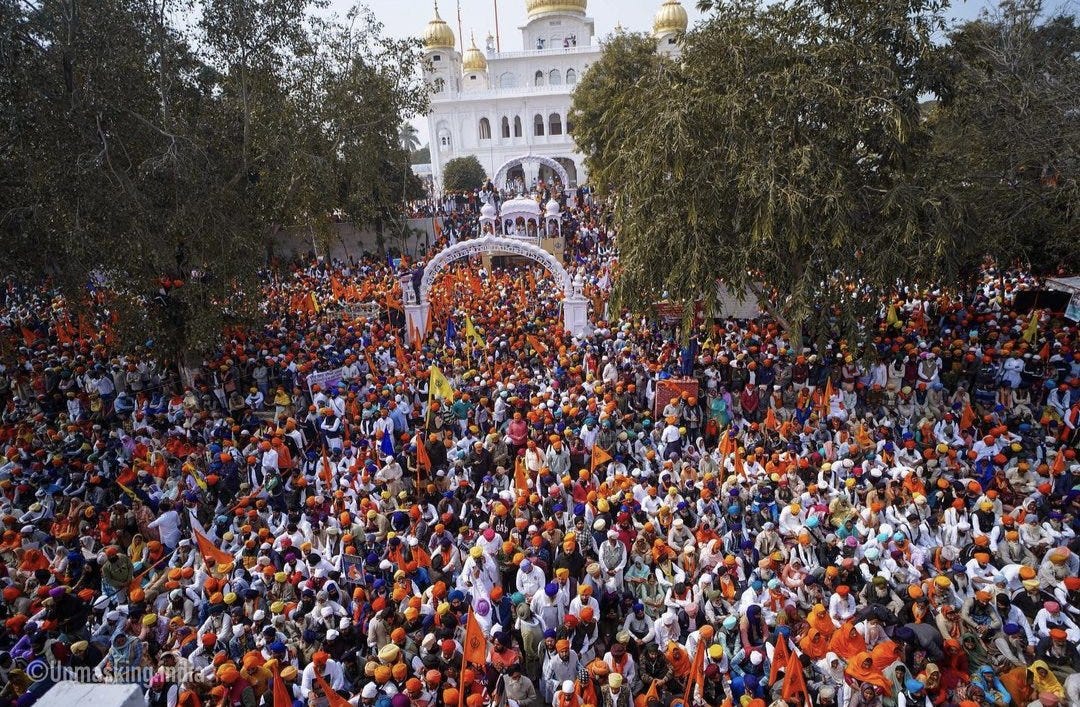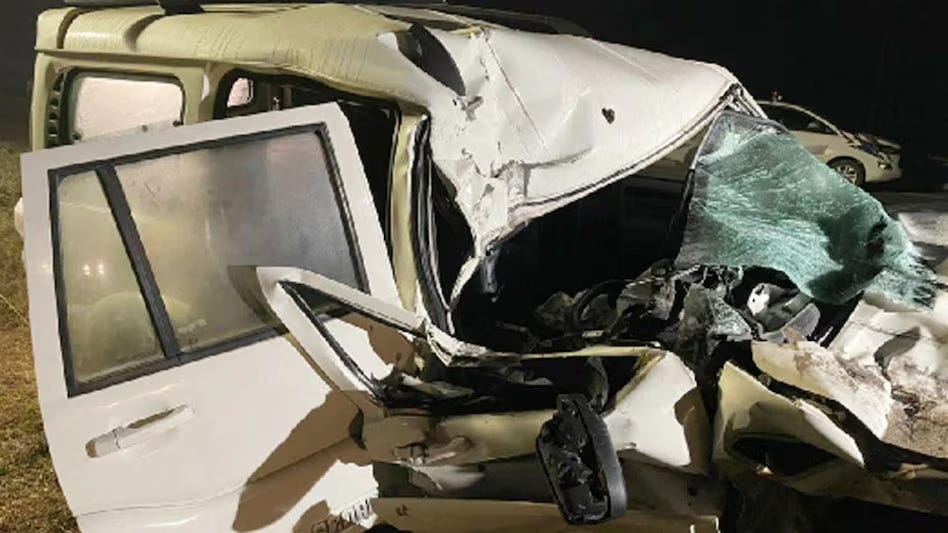Deep Sidhu’s Tragic Death: The Conspiracy Theories vs. The Facts
It is time for the Panth, to move beyond speculation and honour Deep Sidhu’s legacy by focusing on tangible issues facing Punjab, Sikh rights, and farmers’ struggles.
The Life and Death of Activist Deep Sidhu
Remembering Deep Sidhu on his Death Anniversary
The third bhog ceremony of Deep Sidhu was held at his ancestral village, Muktsar, Punjab, on February 15, 2025, marking three years since his sudden and controversial death in a road accident. The gathering saw the participation of Sikh activists, farmers' unions, and community leaders, reflecting the continued impact of Deep Sidhu’s activism.
Giani Harpreet Singh, former Jathedar of Takht Damdama Sahib, addressed the gathering, recalling Deep Sidhu as a fierce voice for Punjab’s sovereignty and farmers’ rights. He reiterated demands for justice and accountability, while also cautioning against reckless speculation regarding Deep Sidhu’s death. He stated:
"While we seek justice for every son of Punjab, it is our duty not to spread conjectures that distract us from real struggles. The Panth must stand on the foundation of truth, not assumptions."
Despite such caution, conspiracy theories surrounding Deep Sidhu’s death persist. This article examines his life, his political trajectory, the accident, and the overwhelming evidence supporting an accidental death—contrary to assassination theories that some continue to promote.
Deep Sidhu: Activist, Rebel, and Political Maverick
From Law to the Big Screen and Beyond
Sandeep Singh Sidhu, popularly referred to as Deep Sidhu, was born in Muktsar, Punjab, in 1984. A law graduate, he initially pursued a legal career, working with corporate firms before transitioning to acting. His breakthrough came with Jora Das Numbria (2018), a film portraying Punjab’s power struggles.
However, Deep Sidhu’s true impact was not in cinema, but in activism. In 2019, he campaigned for BJP MP Sunny Deol, only to later break ties with the saffron party and become a vocal supporter of Punjab’s farmers’ protests.
The Red Fort Incident and Fallout
On January 26, 2021, during the farmers’ protests, Deep Sidhu was accused of leading a faction of protestors to the Red Fort in Delhi, where a Nishan Sahib flag was hoisted. This act was used by both the Indian state and farmer unions to distance themselves from him. While Delhi Police charged him with serious offenses, major farmer leaders like Rakesh Tikait labeled him a "government agent," leading to distrust from all sides.
His arrest, subsequent bail, and continued activism made him a controversial yet influential figure.
The Fatal Crash: Official Findings vs. Speculation
Chronology of Events
On February 15, 2022, Deep Sidhu was driving his Mahindra Scorpio on the KMP Expressway near Sonipat, Haryana, en route from Delhi to Punjab. His SUV collided with a moving 22-wheel truck at high speed. Deep Sidhu suffered fatal head injuries, while his co-passenger, Reena Rai, survived with minor injuries.
Forensic and Police Investigation
Postmortem reports confirmed severe head trauma as the cause of death.
Skid marks suggested high-speed braking, indicating Deep Sidhu was overspeeding.
A partially consumed liquor bottle was found in the car, though no conclusive toxicology reports were released.
Truck driver Qasim Khan was arrested but maintained the crash was an accident.
Police charged him with negligent driving under IPC Section 304A.
Survivor Testimony and Confessions: The Overwhelming Evidence
Reena Rai’s Testimony: A Key Witness Speaks
Deep Sidhu’s co-passenger and close companion, Reena Rai, provided the most critical eyewitness account:
She stated that Deep Sidhu was driving fast, and the truck ahead braked suddenly.
She had been asleep due to jet lag and woke up to the crash.
Rai later released a video debunking conspiracy theories, stating:
“Over-speeding killed Deep Sidhu, not a conspiracy.”
Truck Driver’s Confession
Qasim Khan, the truck driver, confessed that he did not see Deep Sidhu’s car approaching and that the crash was purely accidental. He had no prior knowledge of who Deep Sidhu was.
These two first-hand testimonies alone demolish any notion of a pre-planned assassination.
Conspiracy Theories: Political Opportunism or Genuine Concerns?
Despite overwhelming forensic and witness evidence, Deep Sidhu’s death became the subject of numerous conspiracy theories.
1. The “Targeted Killing” Theory
Some activists claim that Deep Sidhu was too influential and too radical for the Indian establishment, and thus he was assassinated. This theory rests on:
His growing influence in Sikh youth circles.
His vocal criticism of mainstream Sikh leadership.
His connections with Waris Punjab De, a pro-Sikh sovereignty movement.
However, there is zero credible evidence supporting this claim. Unlike previous politically motivated killings, there was no gunfire, no suspicious actors on the scene, and no history of threats against his life.
2. The ‘Vehicle Tampering’ Theory
Another theory suggests that Deep Sidhu’s SUV was deliberately tampered with before he set off.
Conspiracy theorists point to airbags failing to save him.
They claim the car was removed too quickly from the scene.
They question the speed at which the investigation was closed.
Yet, the SUV's airbag deployment was consistent with the force of impact, and vehicle tampering would not explain why Reena Rai survived unharmed.
3. The ‘Truck Braking’ Theory
Some allege that the truck driver deliberately caused the accident under government instruction.
However, the truck was already moving, making a premeditated hit nearly impossible.
The driver had no knowledge of Deep Sidhu and was on a routine transport route.
This theory is logically flawed and contradicts basic physics.
The Responsibility of Sikh and Panthic Leadership
While it is natural for Deep Sidhu’s supporters to seek answers, the spread of conspiracy theories without evidence is irresponsible.
The criminal case is still ongoing, and unfounded speculation can obstruct justice.
Sikh leaders, activists, and media outlets must be careful about fueling baseless narratives, as this distracts from real issues like farmers' rights, Sikh sovereignty, and state suppression of activists.
The Panth must stand for truth, and that truth—however painful—is that Deep Sidhu’s death was a tragic accident, not a targeted killing.
If Sikh activists cry "conspiracy" every time a political death occurs, the credibility of genuine Sikh causes gets diluted. Responsible leadership must focus on evidence-based advocacy, not conjecture.
In Summary: A Tragedy, Not an Assassination
Deep Sidhu’s death remains an emotional issue, but emotions cannot override facts.
The forensic evidence, survivor testimony, and truck driver’s confession all confirm an accidental death.
The absence of foul play indicators undermines conspiracy theories.
Deep Sidhu’s own actions—overspeeding on a highway at night—in all probability, led to his demise.
Looking Ahead– The Need for Panthic Clarity and Focus
Deep Sidhu’s death remains an emotional issue, but emotions cannot override facts. The forensic evidence, survivor testimony, and truck driver’s confession all confirm an accidental death. However, his memory should not be reduced to a subject of political speculation or baseless paranoia. Instead, the Panth must ask itself whether the fixation on conspiracies is preventing real progress on issues that matter. Today, the Sikh community finds itself at a crossroads, embroiled in internal crises when its focus should be on strengthening its institutions, protecting its rights, and securing its future.
The Hukamnama issued from Sri Akal Takht Sahib on December 2, 2024, which called for urgent reforms and stricter adherence to Sikh principles, has yet to be fully complied with. The Shiromani Akali Dal (SAD) remains in turmoil, with its membership drive mired in controversy, further weakening its standing as the primary Panthic political party. At a time when the SGPC elections loom, and key issues such as the protection of historic Gurdwaras, farmers' rights, and Sikh political representation require immediate attention, continuing to chase unsubstantiated conspiracy theories is a disservice to the Panth.
It is time for the Panth to move beyond speculation and honour Deep Sidhu’s legacy by focusing on tangible issues facing Punjab, Sikh rights, and farmers’ struggles. Deep Sidhu was a man of action, not conspiracy—his memory should be preserved in the spirit of his activism, not distorted through fabricated narratives that serve no real purpose.
The duty of every Sikh leader today is to ensure that truth, not misinformation, guides the Panth. Leadership in Sikhism has always been about courage, responsibility, and unwavering commitment to justice. That commitment must be rooted in facts and reality, not in myths that divert the community’s energy from real battles.
If the Panth is to reclaim its strength, rebuild its institutions, and fight for justice, it must do so through truth and clarity, not by embracing unfounded fears and distractions. This is the lesson that must be learned from Deep Sidhu’s life and death—a lesson in courage, not in confusion.






